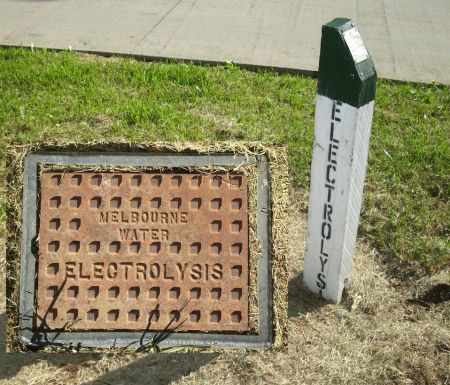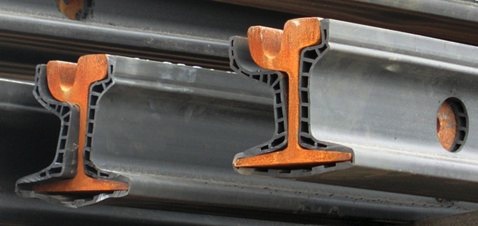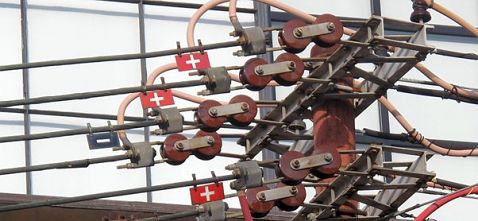Melbourne Tram Museum
- Follow Melbourne Tram Museum on Twitter
- Follow Melbourne Tram Museum on Facebook
- Follow Melbourne Tram Museum on Instagram
- Follow Melbourne Tram Museum on Pinterest
- Follow Melbourne Tram Museum on Tumblr
- Subscribe to Melbourne Tram Museum's RSS feed
- Email Melbourne Tram Museum
Electrolysis: the destructive by-product of electric traction
 Electrolysis
test point near Preston Workshops, 2010.
Electrolysis
test point near Preston Workshops, 2010. - Photograph Mal Rowe.
Many of us may remember a secondary school science experiment where a silver coin and a copper coin were submerged in a suitable solution and the terminals of a battery applied connected to each coin. After a while, the copper coin was coated with a thin layer of silver. It seemed like a good way to turn a penny into two shillings!
That process is electrolysis – the electric current carried a small amount of the metal from one coin to the other. The same thing can happen when the electric current that powers Melbourne’s trams and trains flows between various metal objects on its way back to the substation.
Getting the power to the trams
All of Melbourne’s electric trams and trains run on Direct Current (DC) – when they were first built that was the best way to get optimal performance out of a traction motor. Even today, when motors and motor control techniques are very different, and modern heavy rail uses Alternating Current (AC) supply, all tram and light rail systems still use either 600V or 750V DC supplies to the vehicles.
Put simply the electric circuit looks like this:

The electricity is fed out through the trolleywire, through the tram (where it drives the traction motors) and then flows back to the substation through the rails. For a current to flow there has to be a complete circuit involving paths out and back to the substation. All of those paths have some resistance to the flow of current, so the voltage (think pressure) drops off a bit along the way. Of the 600V at the substation, perhaps 20V may be lost in the trolleywire and another 20V in the rails on the path back to the substation. So only 560V is available at the tram.
Some people may remember being at a terminus late at night and watching the lights in the tram dim and brighten as another tram moved along the tracks – taking more or less current from the overhead. That’s the effect of line and rail resistance.
Getting it all back through the rails
It’s not much of a problem stopping the electricity ‘leaking’ out of the trolley wire – that’s well insulated. However, the rails are usually not well insulated – they are after all buried in the ground for tramways in particular. The result is that some of the return current sometimes takes a path back to the substation through other paths – including the ground itself and various pipes buried in the ground.
So our more complete circuit looks like this:

Note that some of the electric current is taking a short cut on the way back to the substation, perhaps via water or gas pipes or even the lead sheathing that was used on telephone cables. When the traction current leaves that pipe electrolysis occurs: small amounts of metal from the pipe or sheath are taken away by every little bit of electricity ‘taking a short-cut’ via that pipe.
A more detailed path might look like this:

The current in the diagram bypasses the gap in the rail (R) via a water pipe (W) and a sheathed telephone cable (C) then returns to the rail after the break on it way back to the power house. The people who own these pipes get pretty upset, because over a longish period enough metal is taken from their pipes and sheathes to make a hole.
So how do we stop the return current using pipes and sheaths as a shortcut?
There are two primary approaches to preventing current leaking from the return path.
1. Keep the rails out of contact with the ground.
For heavy railways placing the rails on wooden or concrete sleepers on top of dry ballast minimises the contact with the ground and the pipes buried in it. That’s also the approach taken by some recently constructed tramways – notably the Gold Coast, but also the Box Hill extension in Melbourne. The technique for tramways is to encase the rails in some sort of insulating ‘boot’ so that it is not connected to the ground. Here’s a picture of one type of ‘boot’.
 One
type of insulating ‘boot’ used for tramways rails.
One
type of insulating ‘boot’ used for tramways rails. - Photograph Mal Rowe.
It’s not easy to ensure that the electrical insulation is kept intact throughout the track laying process – Gold Coast had to go back and fix a lot of problems after the trams opened.
2. Provide a lower resistance path so that leakage currents mostly use that rather than the ground (and the pipes in it).
The older traditional ways to minimise leakage on traditional tramways is to accept that the rails will be in damp soil and running water, but to provide other – lower resistance – paths so that most of the current gets back to the substation without using someone’s pipes as a shortcut. One form of these low resistance paths are called ‘negative feeders’ and are often strung along the road alongside the ‘positive feeders’ that boost the power to the trolleywire away from the direct connection to the substation.
 Negative
and positive feeders.
Negative
and positive feeders. - Photograph Mal Rowe.
The negative feeder above is (of course) marked with a ‘-’ sign. Another way to minimise the resistance along the preferred path back to the substation is to ensure the rails show minimum resistance to electric current. That is achieved by:
- welding the rails together at joints, or by having copper bonds that bypass non-welded joints; and
- bonding connecting rails together so that all four rails are used in the path back to the substation; and
- using copper bonds to bypass ‘special works’ like points and crossings because the manganese steel used in these has a higher electrical resistance than ordinary rail.
It gets more complex than that with other ‘electrical tricks’ used to persuade the return current to stay where it is supposed to and keep it away from buried pipes and other metal infrastructure.
For those who want the full engineering description, the Victorian Electrolysis Committee’s VEC resource manual is a good reference. The Victorian Electrolysis Committee has the task of coordinating and regulating activities that might lead to electrolysis problems in the state and the resource manual includes some interesting history as well as the technical data.